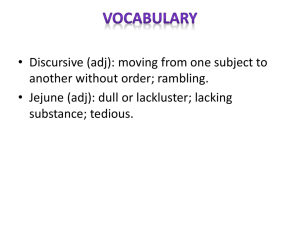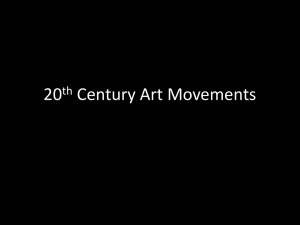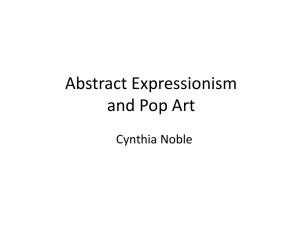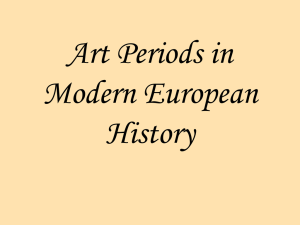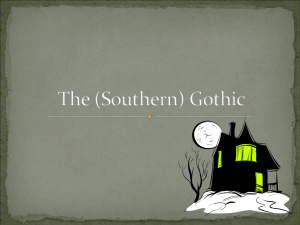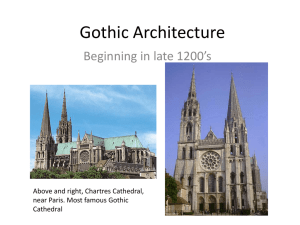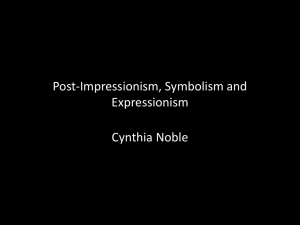20th Century Short Stories with MOVEMENTS (ISMS)
advertisement
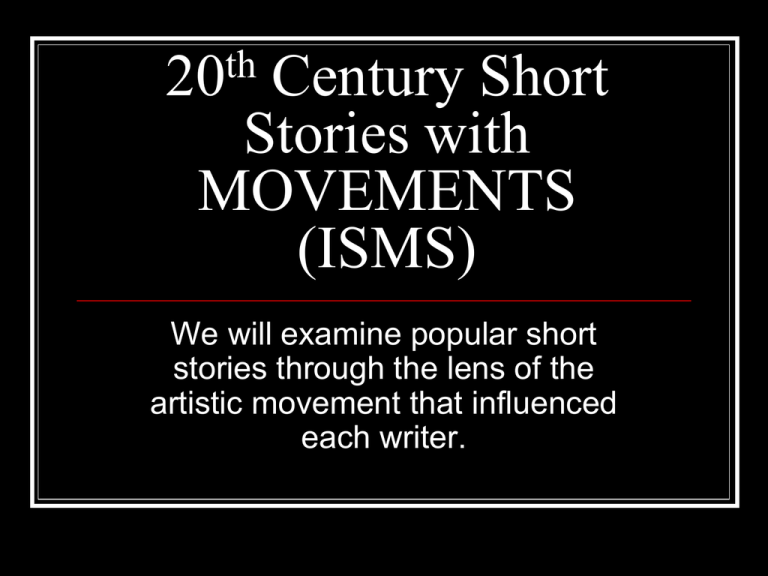
th 20 Century Short Stories with MOVEMENTS (ISMS) We will examine popular short stories through the lens of the artistic movement that influenced each writer. Introduction The early 20th century pulled influences from previous artistic movements (so we will examine movements from the 18th century onward) in addition to focus on 20th century artistic movements. Your task will be to learn the basic definition of each artistic movement with a writer from our unit as well as a popular artist. Dates are important. Short Stories in the Unit with author and date The Metamorphisms by Franz Kafka (Handout) -written in 1916 The Wall by Jean Paul Sarte (Handout) -written in 1939 The Devil and Tom Walker by Washington Irving (Textbook) - written in 1824 Bliss by Katherine Mansfield (Handout) -written in 1920 The Jilting of Granny Weatherall by Katherine Ann Porter (Textbook) -written in 1930 A Rose for Emily (Textbook) -written in 1930 Trapped in A Comic Book by Jules Feiffer (Textbook) -written in 1986 Use the dates to help you decide which literary unit the author found as an influence. How to critique art: remember “DAIJ” Focus on Description It stands for Description, Analysis, Interpretation, Judgment or “Dem Apples Is Juicy.” How to critique art: remember DAIJ: Focus on “Description”. To start: give the title, artist, medium, etc. Next, describe the colors that you see. What does the art look like? Are the colors bright or subdued? What is it made of? What objects and textures do you see in it? What is the entrance point. (I’ll explain). Remember: This is all factual, there is NO OPINION involved in description. Now you try. Okay, give me a “D”. How to critique art: remember DAIJ: Focus on “Analysis”. Next, tell how all of the answers form the “Description” stage are related to one another. i.e. how the above facts are organized and compliment one another or create harmony or distress. This step can be the most confusing because it is very similar to the first step and can easily overlap. A good suggestion is to think about some of the principles of art: movement, variety, proportion, emphasis, balance, and contrast. How to critique art: remember DAIJ: Focus on “Interpretation”. Interpretation. Basically, how does the painting make you feel? What does it make you think of? Don’t say the artwork “sucks”. Not yet. (That comes in the next step.) What do you think the artist is trying to communicate to you as a viewer? Just because this step is more open-ended than the previous steps, and there are not any right or wrong answers, I still think it is the most important (and fun) step. How to critique art: remember DAIJ: Focus on “Judgment”. Judgment. Okay, so whether or not in the previous step you interpreted the paintings as “reminding you of regurgitated lunchroom tater tots”, you NOW say whether it is a success or a failure in your opinion. Also, do you feel it is original or unoriginal? Would you hang it on your wall at home? Here is the place for all the gut feelings you had when you first looked at the artwork. Agenda Gothicism Modernism Post-Modernism and Existentialism and Surrealism Expressionism Impressionism and Post-Impressionism Pop Art Gothicism Definition Time Period: Late 18th century; early 19th century (parallel to Romantic movement) Gothic Fiction (sometimes referred to as Gothic horror) is a genre of literature that combines elements of both horror and romance. As a genre, it is generally believed to have been invented by the English author Horace Walpole, with his 1794 novel The Castle of Orantho. Modern Day Gothicism http://www.youtube.com/watch?v=FdL496 Oc3VQ History of the Gothic Movement The word Gothic, is very old and was used from the Renaissance on to signify the art of the Middle Ages. It was named after the German tribe of the Goths who once had invaded Italy and broken up the Roman Empire to revive the Classic age. The term Gothic had a negative connotation because the Italians blamed the Goths for breaking up the empire. The art style of this period they called Gothic, by which they meant barbaric. Gothic Literature/ Writers A literary genre that began in England in the late 1700s. The word “Goth” came from the architecture where it describes castles and cathedrals as they served for the mysterious settings of early Gothic fiction. Writers: Percy Shelley, John Keats, Lord Byron, Edgar Allan Poe, Mary Shelley. Elements of Gothic Style (Study this carefully. We will do an entire unit on Gothicism later in the semester). Bleak or remote settings Macabre or dismal settings Characters in psychological or physical torment Supernatural or otherworldly elements Strong language full of dangerous meanings Gothic Architecture Gothic Art More Art “American Gothic” by Grant Wood was created in the 20th century. However, it depicts a house from 1881 that is described as Gothic revival. A Definition of Modernism Time Period: late 19th century mid-20th century (1945) Definition: Modernism describes both a set of cultural tendencies and an array of associated cultural movements arising from wide-scale and far reaching changes in Western society in the 19th and early 20th century. BIG CHANGE: WWI. The term encompasses the literature, religious faith, social organization and daily life were becoming outdated in the new economic, social and political conditions of an emerging, fully industrialized world. Modernism rejected the lingering certainty of Enlightenment thinking, and also that of a benignly, intervening, all-powerful Creator. CONTROVERSIAL-influenced by Charles Darwin’s ideas on evolution. Famous Artists and Authors: Artists: Manet, Hans Hoffman Authors: Baudelaire, Flaubert An example of art from the Modernist movement “Rope Swinger” by Hans Hoffman: mid 20th century. This is also considered abstract expressionism. A definition of Post-Modernism Time period: mid-late 20th century (specific start1945) Postmodernism-literally means ‘after Modernism movement’. This movement carries Modernist styles or practices to the extreme! Largely influenced by Western European “Disillusionment” induced by WWII. It refers to an artistic state lacking a clear central hierarchy or organizing principle and embodying extreme complexity, contradiction, ambiguity, diversity or interconnectivity. Famous Existential Authors: Existentialism emerges from a movement in twentieth-century literature and philosophy Kafka and Sarte. Famous Post-Modern Authurs: Arthurs: William Burroughs, and Kurt Vonnegut. NOTE: Postmodernist writiers often point to earlier novels and short story collections as inspiration for their experiments with narrative and structure. Artists: Tristan Tzara (dadaism specifically). Rene Magritte and Salvador Dali (surrealism specifically). Definition of Existentialism: Given to 19th and 20th century philosophers who share a belief that philosophic thinking begins with the human subject-not merely the thinking subject, but the acting, thinking, feeling, living human individual. In existentialism, the individual’s starting point is characterized by what has been called the “existential attitude” or sense of disorientation of confusion in the face of an apparently meaningless or absurd world. Surrealism defined as an offshoot of Post-Modernism Surrealism is a cultural movement that began in the 1920s and is best known for the visual artworks and writings of the group members. Surrealist works feature the element of surprise, unexpected juxtapositions (a paring of two unlike things, i.e. pox, politics, and beans). However, many Surrealist artists and writers regard their work as an expression of the philosophical movement first and foremost with their works being an artifact. In the 1920s, the movement developed from the Dada movement, and spread around the globe affecting the visual arts, literature, film and music of many countries and languages, as well as political thought and practice and social theory. Famous Surrealist authors and artists: Authors: Marx Ernst, Franz Kafka, Shirley Jackson Artists: Joan Miro, Pablo Picasso, Salvador Dali, Rene Magritte Surrealist Artwork- Rene Magritte “C’est n est pas une pipe” or “this is not a pipe” AND IT ISN’T. Surrealist Artwork-Salvador Dali “The Persistence of Memory” Surrealist artwork: Max Ernst and “The Couple in Lace” The Expressionism Movement Dates: 20th century-roughly 1914-1945 Definition: Expressionism is the tendency of an artist to distort reality for an emotional effect: it is a subjective art form. Expressionism is exhibited in many art forms, including painting, literature, theater, film, architecture, and music. The term often implies emotional angst. the artist's subjective expression of inner experiences was emphasized; an inner feeling was expressed through a distorted rendition of reality. Expressionist Artists/Authors: Edward Munch, Vincent Van Gogh, Max Weber Authors: Nietzsche, Franz Kafka Expressionism in architecture: Babelsberg “Einsteinturm” in Potsdam, Germany Expressionist Artwork: “The Scream” by Edward Munch and “View of Toledo” by El Greco influenced the Expressionism Movement (But it was painted in the 16th century) Expressionist Art- “On White II” by Wassily Kandinsky-1923 Please D.A.I.J. this painting. Expressionism is the opposite of Impressionism (a quote to prove it) The term was also coined by Czech art historian in 1910as the opposite of Impressionism. “An Expressionist wishes, above all, to express himself…(An Expressionist rejects) immediate perception and builds on more complex psychic structures…Impressionists and mental images that pass through mental peoples’ souls as through a filter which rids them of all substantial accretions to produce their clear essence and are assimilated and condensed in more general forms, into types, which he transcribes through simple short-handed formulae and symbols.” Gordon, 1987) Impressionism Defined Dates: 1860s-mid 20th century Impressionism was a 19th century art movement that began as a loose association of Paris-based artists exhibiting their art publicly in the 1860s. The name of the movement is derived from the title of the Claude Monet work, “impressionist Sunrise” (this is a test question) Characteristics of impressionists paintings include visual brush strokes, open composition, emphasis on light and its changing qualities (often exentuating the effects of the passing of time) ordinary subject matter, the inclusion of movement as a crucial element of human perception and experience and unusual visual angles. Impressionistic Authors and Artists Authors: James Joyce Artists: Claude Monet, Winslow Homer, Pierre-Auguste Renior, Edgar Degas “Der Star des Ballets” by Edgar Degas” Gustave Caillebotte-”La Place de l’Europe, temps la pluie” (a place in Europe, when it rains, I think) Pop Art Pop Art was a visual art movement that emerged in the 1950s in Britain and the United States. The origin of the term Pop Art is unknown but is often credited to British art critic Lawrence Alloway in an essay titled "The Arts and the Mass Media", although he uses the words "popular mass culture" instead of "pop art". Alloway was one of the leading critics to defend Pop Art as a legitimate art form. Pop Art Part Deux It was one of the biggest art movements of the twentieth century and is characterized by themes and techniques drawn from popular mass culture, such as television, movies, advertising and comic books. Pop art is widely interpreted as either a reversal or reaction to Abstract Expressionism or an expansion upon it. Pop Art Continued… Pop Art aimed to employ images of popular culture as opposed to elitist culture in art, often emphasizing kitsch and thus targeted a broad audience. It was easy to understand, easy to recognize because it was iconic and accessible to the mass public. Pop art is sometimes considered to be very academic and unconventional, but it was always easy to interpret. Pop Artists: Crash, Jim Dine, Keith Haring, Roy Lichtenstein , Andy Warhol and Tom Wesselmann Summary You must know which movements influenced your story and your author. You must remember which movements influenced other movements. You must know one author and one artist from each movement for the “ISMS” exam.
